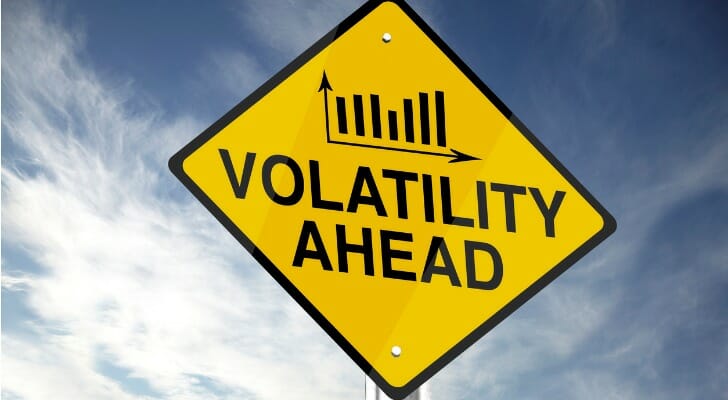 When trading stocks and other securities, it can be helpful to use technical indicators to assess volatility. Average true range, or ATR, is one such indicator that’s often used to track securities’ price movements over defined time periods. Though it originally was applied to commodities trading, day traders can use ATR to gauge volatility when determining whether to buy or sell stocks. The average true range relies on a specific formula for measuring volatility. A financial advisor can help you develop an understanding of investment terms and strategies as well.
When trading stocks and other securities, it can be helpful to use technical indicators to assess volatility. Average true range, or ATR, is one such indicator that’s often used to track securities’ price movements over defined time periods. Though it originally was applied to commodities trading, day traders can use ATR to gauge volatility when determining whether to buy or sell stocks. The average true range relies on a specific formula for measuring volatility. A financial advisor can help you develop an understanding of investment terms and strategies as well.
Defining Average True Range
Average true range (ATR) represents the average of true ranges over a specified time period. In simpler terms, it measures the volatility of an asset by looking at that asset’s price range over time. ATR also takes into account gaps in price movement when measuring how volatile a security may be.
The time period used for average true range calculations can vary. It’s common for ATR to be based on a security’s 14-day moving average, though the periods used can be shorter or longer. A shorter time period may be used to measure recent volatility for a security while the period may extend well beyond the 14-day moving average to measure long-term volatility.
How to Calculate Average True Range
As with other technical indicators, there’s a specific formula that’s used to calculate a security’s average true range. The formula goes like this:
ATR = (Previous ATR x (n-1) + TR) ÷ n
In this formula, “n” equals the number of periods being measured, while “TR” represents true range. The true range for a trading period is the greatest of these:
- Current high minus the previous day’s close
- Current low minus the previous day’s close
- Current high minus the current low
To find average true range you first need to complete these true range calculations. The true range number can be positive or negative but to find ATR, you’ll need to use the greatest value.
Once you’ve done the calculations to find average true range it’s possible to plot them out on a chart. As price movements change, the ATR indicator can move up or down on the chart. In reading an ATR chart, you can visualize when volatility for a specific security is increasing or decreasing across a set time period. This can help with determining when it might make sense to place a trade order to buy or sell a particular security.
What Average True Range Tells Investors
 Once again, average true range is used to measure volatility. Keeping volatility in sight is important for active day traders who may seek to capitalize on market movements to increase returns or avoid losses. If you’re a passive investor or prefer a buy and hold strategy, tracking volatility also matters but you may rely less on technical indicators like ATR to guide investment decisions.
Once again, average true range is used to measure volatility. Keeping volatility in sight is important for active day traders who may seek to capitalize on market movements to increase returns or avoid losses. If you’re a passive investor or prefer a buy and hold strategy, tracking volatility also matters but you may rely less on technical indicators like ATR to guide investment decisions.
When ATR is expanding, that’s a signal that volatility is increasing in the market. This can also suggest that there’s more of a push happening in the market to buy or sell the security that’s being tracked. If a security has a high ATR, it may be the result of a sudden increase or decrease in pricing.
When the ATR is low it can be indicative of lower volatility. Tracking ATR as a day trader can be useful for monitoring shifts in volatility and detecting sharp price movements up or down. It’s helpful for managing risk as you can use ATR patterns and trends to effect entrances or exits for individual securities, as well as gauging how large or small of a position you should maintain.
Average true range is most helpful when used alongside other technical indicators. For example, you may also use indicators that measure momentum, such as rate of change (ROC), as well as trend indicators like the simple moving average (SMA). Together, these technical indicators can help paint a more complete picture when attempting to read a security’s buy or sell signals.
Limitations of Average True Range
Average true range can help you better gauge volatility movements but there are some limits as to how it can be used. First, it’s important to remember what ATR does and does not do.
While average true range does track volatility, it doesn’t measure or forecast which way a security’s price is likely to move next. When the market is undergoing a significant bout of volatility a sharp increase in average true range could send misleading signals about which way a stock is trending. Relying on ATR alone could result in taking a position in a security that ends up producing results that run counter to your goals. In other words, you could end up losing money if a shift in ATR doesn’t confirm the trend you were expecting with a stock’s price.
Second, it’s important to keep in mind that the average true range is a subjective way of measuring stocks and other securities. There is no hard and fast rule or baseline ATR you can use as a measuring stick for determining exactly what will happen next where a particular asset is concerned. That’s why it’s important to compare average true range measurements for multiple time periods while also incorporating other technical indicators into your investment approach.
Technical Indicators vs. Fundamental Analysis
Technical analysis relies on technical indicators, such as average true range, moving averages and momentum indicators. This type of analysis looks largely at trends to determine what’s happening with a particular security and what may happen next to guide investment decisions.
Fundamental analysis, on the other hand, takes a different approach. The focus here lies on determining a stock’s intrinsic value based on measures of a company’s financial health. For example, investors may look at key ratios such as price to earnings (P/E), earnings per share (EPS) and projected earnings growth (PEG). The primary concern is on what a company’s fundamentals tell you about its value relative to its price.
Technical analysis may be more commonly used if you’re an active trader, while you may rely on fundamental analysis if you prefer a value investing approach. Understanding how the two compare can help you determine which strategy may work best, based on your investment goals and risk tolerance.
Bottom Line
 Average true range, a metric of technical analysis among in the securities industry, was first developed for commodity traders. It is a way to measure a security’s volatility over a fixed time period. You can use ATR alongside other technical indicators to time the placement of trades. However, while it can be useful in making trading decisions, there are some limitations on what it can tell you about a security’s projected price movements.
Average true range, a metric of technical analysis among in the securities industry, was first developed for commodity traders. It is a way to measure a security’s volatility over a fixed time period. You can use ATR alongside other technical indicators to time the placement of trades. However, while it can be useful in making trading decisions, there are some limitations on what it can tell you about a security’s projected price movements.
Tips for Investing
- Consider talking to a financial advisor about active how active day trading strategies work. Finding a financial advisor doesn’t have to be hard. SmartAsset’s free tool matches you with up to three vetted financial advisors who serve your area, and you can interview your advisor matches at no cost to decide which one is right for you. If you’re ready to find an advisor who can help you achieve your financial goals, get started now.
- If you’re an active trader, choosing an online brokerage that charges no commission fees for stock and exchange-traded funds can help you hold on to more of your investment returns. When comparing online brokerage accounts, consider the minimum amount required to start investing, commission fees for trades as well as the expense ratios you might pay to invest in specific funds.
Photo credit: ©iStock.com/gustavofrazao, ©iStock.com/kentoh, ©iStock.com/aydinynr